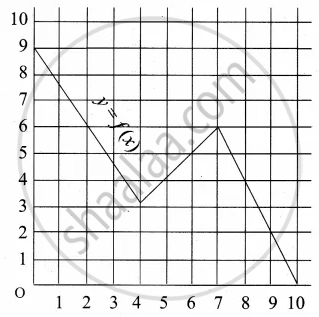Advertisements
Advertisements
प्रश्न
Solve for x.
log2 x + log4 x + log16 x = `21/4`
उत्तर
log2 x + log4 x + log16 x = `21/4`
∴ `logx/log2 + logx/log4 + logx/log16 = 21/4`
∴ `(logx)[1/log2 + 1/log4 + 1/log16] = 21/4`
∴ `(logx)[1/log2 + 1/log2^2 + 1/log2^4] = 21/4`
∴ `(logx) [1/log2 + 1/(2log2) + 1/(4log2)] = 21/4`
∴ `(logx/(log2)) [ 1 + 1/2 + 1/4] = 21/4`
∴ `(logx/(log2)) [(4 + 2 + 1)/4] = 21/4`
∴ `7/4.(logx/log2) = 21/4`
∴ `logx/log2` = 3
∴ log x = 3 log 2 = log23
∴ log x = log 8
∴ x = 8
APPEARS IN
संबंधित प्रश्न
Which of the following relations are functions? Give reasons. If it is a function, determine its domain and range.
- {(2, 1), (5, 1), (8, 1), (11, 1), (14, 1), (17, 1)}
- {(2, 1), (4, 2), (6, 3), (8, 4), (10, 5), (12, 6), (14, 7)}
- {(1, 3), (1, 5), (2, 5)}
find: f(1), f(−1), f(0) and f(2).
A function f : R → R is defined by f(x) = x2. Determine (a) range of f, (b) {x : f(x) = 4}, (c) [y: f(y) = −1].
f, g, h are three function defined from R to R as follow:
(i) f(x) = x2
Find the range of function.
If \[f\left( x \right) = x^3 - \frac{1}{x^3}\] , show that
If for non-zero x, af(x) + bf \[\left( \frac{1}{x} \right) = \frac{1}{x} - 5\] , where a ≠ b, then find f(x).
Write the range of the function f(x) = sin [x], where \[\frac{- \pi}{4} \leq x \leq \frac{\pi}{4}\] .
Write the domain and range of function f(x) given by
Let f and g be two real functions given by
f = {(0, 1), (2, 0), (3, −4), (4, 2), (5, 1)} and g = {(1, 0), (2, 2), (3, −1), (4, 4), (5, 3)}
Find the domain of fg.
If \[f\left( x \right) = \log \left( \frac{1 + x}{1 - x} \right)\] , then \[f\left( \frac{2x}{1 + x^2} \right)\] is equal to
If \[f\left( x \right) = \frac{2^x + 2^{- x}}{2}\] , then f(x + y) f(x − y) is equal to
If f : [−2, 2] → R is defined by \[f\left( x \right) = \begin{cases}- 1, & \text{ for } - 2 \leq x \leq 0 \\ x - 1, & \text{ for } 0 \leq x \leq 2\end{cases}\] , then
{x ∈ [−2, 2] : x ≤ 0 and f (|x|) = x} =
Which sets of ordered pairs represent functions from A = {1, 2, 3, 4} to B = {−1, 0, 1, 2, 3}? Justify.
{(1, 2), (2, −1), (3, 1), (4, 3)}
Which sets of ordered pairs represent functions from A = {1, 2, 3, 4} to B = {−1, 0, 1, 2, 3}? Justify.
{(1, 3), (4, 1), (2, 2)}
Check if the relation given by the equation represents y as function of x:
x2 − y = 25
If f(m) = m2 − 3m + 1, find f(−3)
Find x, if f(x) = g(x) where f(x) = `sqrt(x) - 3`, g(x) = 5 – x
Find the domain and range of the following function.
f(x) = `sqrt((x - 3)/(7 - x))`
Express the area A of a square as a function of its perimeter P
lf f(x) = 3(4x+1), find f(– 3)
Express the following exponential equation in logarithmic form
231 = 23
Express the following logarithmic equation in exponential form
In `1/2` = – 0.693
If f(x) = ax2 − bx + 6 and f(2) = 3 and f(4) = 30, find a and b
If f(x) = 3x + 5, g(x) = 6x − 1, then find (f − g) (2)
Select the correct answer from given alternatives.
If f(x) =`1/(1 - x)`, then f{f[f(x)]} is
Answer the following:
If f(x) = 3x4 – 5x2 + 7 find f(x – 1)
Answer the following:
Find the range of the following function.
f(x) = 1 + 2x + 4x
Given the function f: x → x2 – 5x + 6, evaluate f(2)
A graph representing the function f(x) is given in it is clear that f(9) = 2

Describe the following Range
The data in the adjacent table depicts the length of a person's forehand and their corresponding height. Based on this data, a student finds a relationship between the height (y) and the forehand length (x) as y = ax + b, where a, b are constant.
| Length ‘x’ of forehand (in cm) |
Height 'y' (in inches) |
| 35 | 56 |
| 45 | 65 |
| 50 | 69.5 |
| 55 | 74 |
Find the length of forehand of a person if the height is 53.3 inches
If f(x) = 5x - 3, then f-1(x) is ______
The domain of the real valued function f(x) = `sqrt((x - 2)/(3 - x))` is ______.
Find the domain of the following function.
f(x) = [x] + x
Find the range of the following functions given by `|x - 4|/(x - 4)`
Find the range of the following functions given by f(x) = |x − 3|
Let f(x) = `sqrt(1 + x^2)`, then ______.
If f(x) = x3 – 1 and domain of f = {0, 1, 2, 3}, then domain of f–1 is ______.
The expression \[\begin{array}{cc}\log_p\log_p\sqrt[p]{\sqrt[p]{\sqrt[p]{\text{...........}\sqrt[p]{p}}}}\\
\phantom{...........}\ce{\underset{n radical signs}{\underline{\uparrow\phantom{........}\uparrow}}}
\end{array}\]where p ≥ 2, p ∈ N; ∈ N when simplified is ______.
